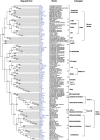The Gypsy Database (GyDB) of mobile genetic elements
- PMID: 17895280
- PMCID: PMC2238898
- DOI: 10.1093/nar/gkm697
The Gypsy Database (GyDB) of mobile genetic elements
Abstract
In this article, we introduce the Gypsy Database (GyDB) of mobile genetic elements, an in-progress database devoted to the non-redundant analysis and evolutionary-based classification of mobile genetic elements. In this first version, we contemplate eukaryotic Ty3/Gypsy and Retroviridae long terminal repeats (LTR) retroelements. Phylogenetic analyses based on the gag-pro-pol internal region commonly presented by these two groups strongly support a certain number of previously described Ty3/Gypsy lineages originally reported from reverse-transcriptase (RT) analyses. Vertebrate retroviruses (Retroviridae) are also constituted in several monophyletic groups consistent with genera proposed by the ICTV nomenclature, as well as with the current tendency to classify both endogenous and exogenous retroviruses by three major classes (I, II and III). Our inference indicates that all protein domains codified by the gag-pro-pol internal region of these two groups agree in a collective presentation of a particular evolutionary history, which may be used as a main criterion to differentiate their molecular diversity in a comprehensive collection of phylogenies and non-redundant molecular profiles useful in the identification of new Ty3/Gypsy and Retroviridae species. The GyDB project is available at http://gydb.uv.es.
Figures




Similar articles
-
Network dynamics of eukaryotic LTR retroelements beyond phylogenetic trees.Biol Direct. 2009 Nov 2;4:41. doi: 10.1186/1745-6150-4-41. Biol Direct. 2009. PMID: 19883502 Free PMC article.
-
The Gypsy Database (GyDB) of mobile genetic elements: release 2.0.Nucleic Acids Res. 2011 Jan;39(Database issue):D70-4. doi: 10.1093/nar/gkq1061. Epub 2010 Oct 29. Nucleic Acids Res. 2011. PMID: 21036865 Free PMC article.
-
Relationships of gag-pol diversity between Ty3/Gypsy and Retroviridae LTR retroelements and the three kings hypothesis.BMC Evol Biol. 2008 Oct 8;8:276. doi: 10.1186/1471-2148-8-276. BMC Evol Biol. 2008. PMID: 18842133 Free PMC article.
-
About the origin of retroviruses and the co-evolution of the gypsy retrovirus with the Drosophila flamenco host gene.Genetica. 1997;100(1-3):29-37. Genetica. 1997. PMID: 9440256 Review.
-
DIRS-1 and the other tyrosine recombinase retrotransposons.Cytogenet Genome Res. 2005;110(1-4):575-88. doi: 10.1159/000084991. Cytogenet Genome Res. 2005. PMID: 16093711 Review.
Cited by
-
A widespread occurrence of extra open reading frames in plant Ty3/gypsy retrotransposons.Genetica. 2011 Dec;139(11-12):1543-55. doi: 10.1007/s10709-012-9654-9. Epub 2012 Apr 29. Genetica. 2011. PMID: 22544262
-
Plant centromeric retrotransposons: a structural and cytogenetic perspective.Mob DNA. 2011 Mar 3;2(1):4. doi: 10.1186/1759-8753-2-4. Mob DNA. 2011. PMID: 21371312 Free PMC article.
-
A highly conserved gene island of three genes on chromosome 3B of hexaploid wheat: diverse gene function and genomic structure maintained in a tightly linked block.BMC Plant Biol. 2010 May 27;10:98. doi: 10.1186/1471-2229-10-98. BMC Plant Biol. 2010. PMID: 20507561 Free PMC article.
-
A chromosome-level genome assembly for Erianthus fulvus provides insights into its biofuel potential and facilitates breeding for improvement of sugarcane.Plant Commun. 2023 Jul 10;4(4):100562. doi: 10.1016/j.xplc.2023.100562. Epub 2023 Feb 21. Plant Commun. 2023. PMID: 36814384 Free PMC article.
-
Network dynamics of eukaryotic LTR retroelements beyond phylogenetic trees.Biol Direct. 2009 Nov 2;4:41. doi: 10.1186/1745-6150-4-41. Biol Direct. 2009. PMID: 19883502 Free PMC article.
References
-
- McClintock B. Mutable loci in maize. Carnegie Inst. Wash. Year book. 1948;47:155–169. - PubMed
-
- Kazazian HH., Jr Mobile elements: drivers of genome evolution. Science. 2004;303:1626–1632. - PubMed
-
- Temin HM. Reverse transcriptases. Retrons in bacteria. Nature. 1989;339:254–255. - PubMed
-
- Craig NL, Craigie R, Gellert M, Lambowitz AM. Mobile DNA II. Washington, DC: ASM Press; 2002.
-
- Mizuuchi K. Transpositional recombination: mechanistic insights from studies of mu and other elements. Annu. Rev. Biochem. 1992;61:1011–1051. - PubMed

